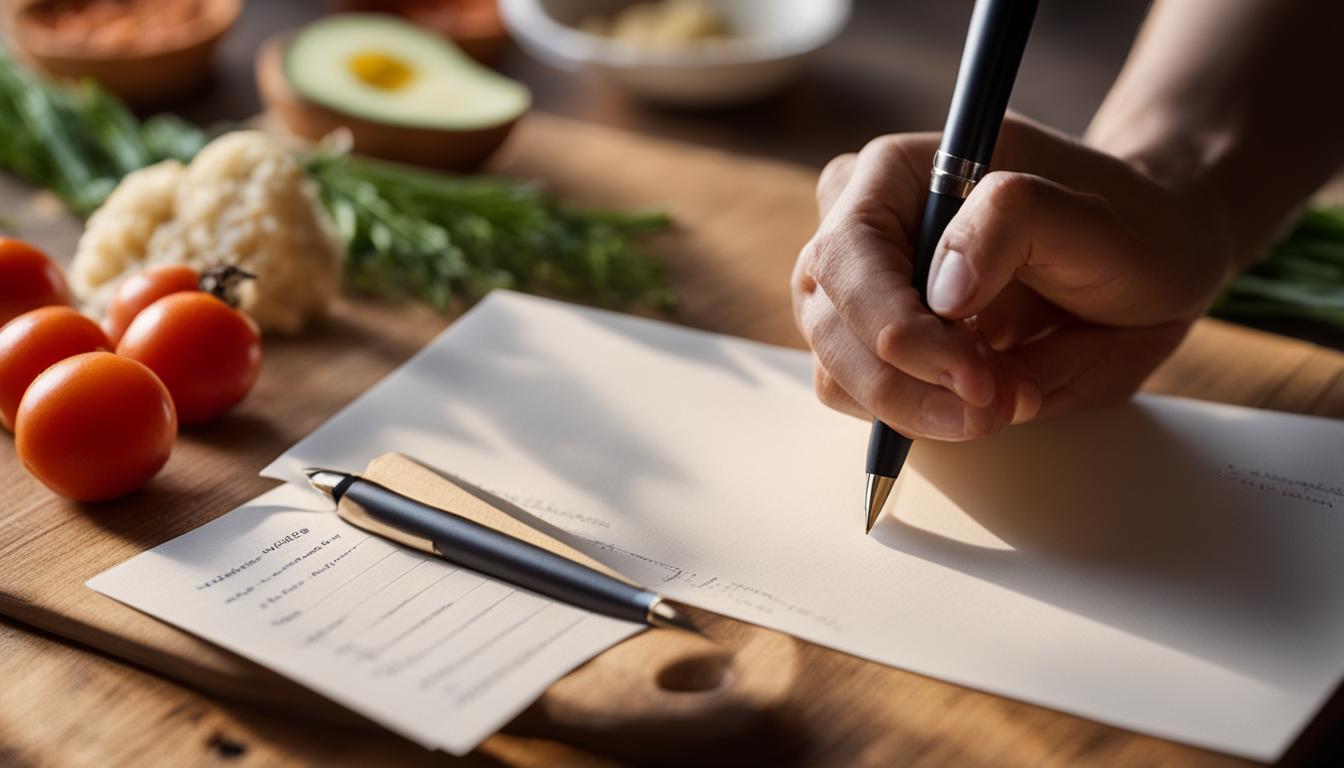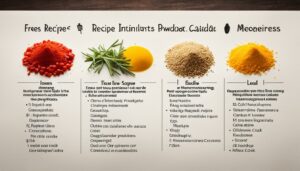Originally posted on December 13, 2023 @ 6:14 am
Welcome to our comprehensive guide on recipe writing! Whether you’re a professional recipe developer or a home cook looking to share your culinary creations, mastering the art of recipe writing is essential for creating successful recipes. In this guide, we will delve into the nuances of crafting recipes and provide valuable insights on how to write them effectively.
Recipe writing involves more than just listing ingredients and steps. It entails the ability to translate cooking instructions into clear and concise words, ensuring that readers can replicate your recipes with ease. From recipe development and testing to nutrition analysis and food styling, we will cover all the crucial aspects of recipe writing.
With helpful tips, expert advice, and step-by-step guidance, this guide will equip you with the skills to write engaging and well-written recipes that resonate with your audience. So, let’s dive in and uncover the secrets to creating delectable recipes that everyone can enjoy!
Contents
- 1 Recipe Development: Creating Flavor-Focused Recipes
- 2 Recipe Writing: Translating Cooking into Words
- 3 Recipe Testing: Ensuring Replicable Results
- 4 Nutrition Analysis: Understanding Nutritional Content
- 5 Food Styling, Photography, and Video: Visual Appeal
- 6 The Rules for Recipe Writing: Tips and Strategies
- 7 Recipe Writing Tips from Dietitians and Bloggers
- 8 Conclusion
- 9 FAQ
- 9.1 What is recipe development?
- 9.2 What is recipe writing?
- 9.3 Why is recipe testing important?
- 9.4 Why is understanding the nutritional content of recipes important?
- 9.5 How important is visual appeal in a recipe?
- 9.6 What are some tips for writing a good recipe?
- 9.7 Are there any valuable tips from experienced recipe writers?
- 9.8 What is the goal of recipe writing?
- 10 Source Links
Key Takeaways:
- Recipe writing is an essential skill for creating successful recipes.
- Clarity, consistency, and maintaining an original voice are crucial in recipe writing.
- Recipe testing ensures replicable results and accuracy.
- Understanding nutrition analysis is important for health-conscious individuals and professionals.
- Enhancing visual appeal through food styling, photography, and video skills can attract and engage readers.
Recipe Development: Creating Flavor-Focused Recipes
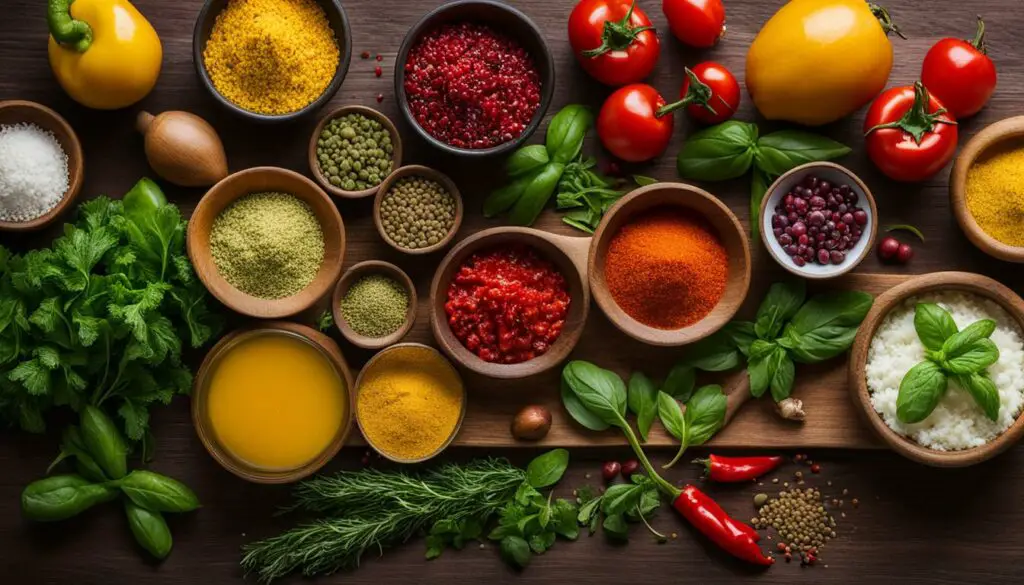
When it comes to recipe development, creating flavor-focused recipes is essential. A well-crafted recipe not only satisfies the taste buds but also considers different dietary needs. Whether you’re catering to plant-based diets, accommodating food allergies and sensitivities, addressing celiac disease (gluten-free), or handling FODMAP intolerance, recipe development requires careful consideration.
For those following plant-based diets, creating flavorful recipes that showcase the natural goodness of fruits, vegetables, legumes, and grains is key. By incorporating a variety of spices, herbs, and cooking techniques, you can elevate the taste of plant-based dishes and make them enticing for all.
When it comes to food allergies and sensitivities, recipe development plays a crucial role in ensuring everyone can enjoy delicious meals without compromising their health. By offering alternatives or substitutions for common allergens, such as milk, eggs, nuts, and gluten, you can create inclusive recipes that cater to individuals with specific dietary restrictions.
Celiac disease, a condition that requires a strict gluten-free diet, is another factor to consider in recipe development. By replacing gluten-containing ingredients with gluten-free alternatives, you can create flavorful recipes that those with celiac disease can enjoy without sacrificing taste or texture.
FODMAP intolerance, a condition where certain carbohydrates can cause digestive discomfort, poses another challenge in recipe development. By carefully selecting FODMAP-friendly ingredients and following low FODMAP cooking techniques, you can create delicious and tummy-friendly recipes that cater to individuals with FODMAP intolerance.
Additionally, recipe development involves making modifications to accommodate different dietary needs, such as reducing fat, sodium, and sugar content. By offering healthier alternatives or adjusting ingredient quantities, you can create flavorful recipes that align with various dietary requirements.
Recipe development is an opportunity to explore flavors, experiment with ingredients, and create culinary experiences that cater to a diverse range of dietary needs. By understanding the nuances of different diets and dietary restrictions, you can develop recipes that are not only delicious and vibrant in flavor but also inclusive and accessible to all.
Stay tuned for the next section, where we delve into the art of recipe writing and how to effectively translate cooking into words.
Recipe Writing: Translating Cooking into Words
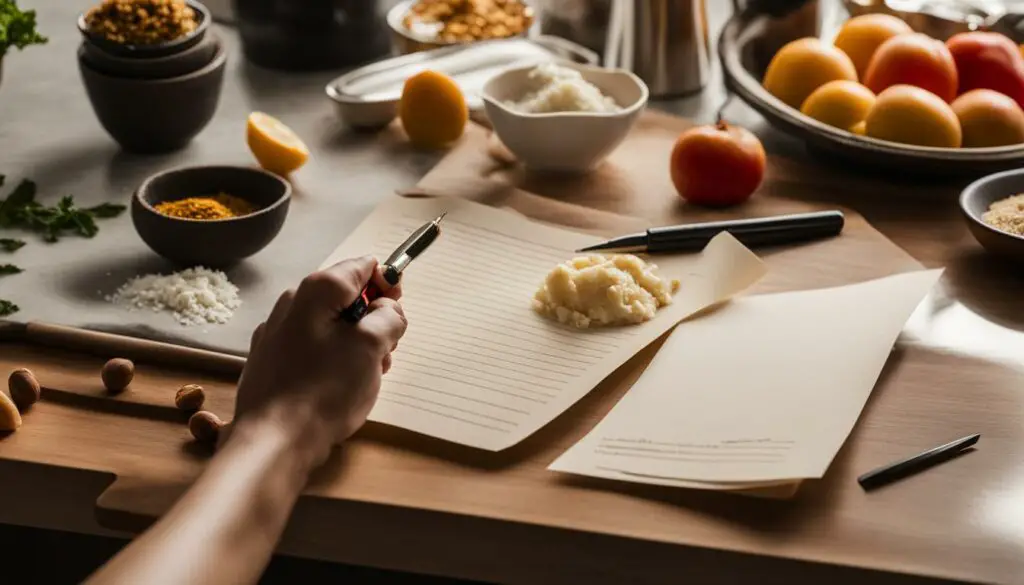
Recipe writing is an art that involves translating cooking instructions into clear and concise words. It is not just about listing ingredients and steps; it’s about capturing the essence of a dish and guiding the reader through the cooking process. To write a recipe that resonates with your audience, there are a few key elements to consider.
Clarity and Consistency
When writing a recipe, clarity is paramount. Use simple language and avoid jargon or complex terminology that might confuse your readers. Clearly explain each step, ensuring that the instructions are precise and easy to follow. Consistency is also crucial for a seamless cooking experience. Use a consistent format throughout your recipe, including consistent measurements, abbreviations, and cooking terminology.
Finding Your Original Voice
Recipe writing is an opportunity to infuse your unique personality and style into your instructions. Develop an original voice that reflects your cooking expertise and personal flair. Whether it’s a casual and conversational tone or a more formal approach, let your voice shine through to engage your audience and make the recipe feel authentic.
Grammar and Punctuation
Good grammar and punctuation are essential for recipe writing. Pay attention to proper sentence structure, capitalization, and punctuation marks. Make sure to proofread your recipe thoroughly to catch any errors or typos that might impact the clarity or understanding of your instructions.
Adhering to Recipe Writing Styles
There are different recipe writing styles, such as narrative, concise, or technical. Choose a style that aligns with your target audience and the type of recipe you’re writing. For example, a dessert recipe might benefit from a more descriptive and narrative style, while a technical recipe like bread making might require a more precise and concise approach.
Incorporating these principles into your recipe writing will help you create recipes that stand out with clarity, consistency, and originality. By using language effectively and paying attention to grammar and punctuation, you can ensure that your instructions are not only easy to follow but also enjoyable to read. Let your unique voice shine through in your recipes to create a connection with your readers and make your dishes truly come alive.
Recipe Testing: Ensuring Replicable Results

Recipe testing is an indispensable step in the recipe writing process. This crucial stage guarantees that a recipe can be replicated with consistent results each time it is prepared. Professional testers play a vital role in this process, meticulously examining and refining the instructions to ensure accuracy and reliability for home cooks.
Through rigorous testing, professional testers meticulously follow the recipe’s instructions, measuring each ingredient precisely and meticulously recording the cooking times and temperatures. This meticulous attention to detail guarantees that the desired outcome can be reliably achieved by anyone following the recipe.
Moreover, recipe testing not only ensures consistent results, but it also helps identify any potential pitfalls or challenges that home cooks may encounter while preparing the dish. By thoroughly testing the recipe, professional testers address any ambiguities or omissions and provide clarifications or additional instructions to achieve optimal results.
Professional testers bring their expertise to assess the recipe’s feasibility, examining its clarity, complexity, and overall effectiveness. Their invaluable feedback and input significantly contribute to refining the recipe and ensuring that it is accessible and achievable for a wide range of home cooks.
Recipe testers ensure that the written instructions are accurate and can be successfully replicated by a home cook, providing invaluable feedback for recipe creators to refine and improve their recipes. Their dedication and attention to detail ensure that every dish turns out as delicious and satisfying as intended.
Professional Testers: The Key to Recipe Success
Professional testers are highly skilled individuals who bring years of experience and knowledge to the table. They possess an acute understanding of recipe development, cooking techniques, and flavors, enabling them to pinpoint areas that require improvement and suggest modifications to enhance the recipe’s overall quality.
These culinary experts not only evaluate the taste and texture of the final dish but also assess the recipe’s clarity, coherence, and overall appeal. With their meticulous approach, they identify any potential inconsistencies or confusing instructions, ensuring a seamless cooking experience for home cooks.
Recipe testing is a collaborative process that involves open communication between the testers and recipe creators. This allows for a dynamic exchange of ideas and insights, leading to further refinement and improvement of the recipe. By working closely together, professional testers and recipe creators can ensure that the final recipe meets the highest standards of excellence.
To showcase the importance of recipe testing, here are some insights from renowned professional testers:
| Name | Testimonial |
|---|---|
| Julia Roberts | “Recipe testing allows me to ensure that the recipes I develop are foolproof and achievable for all home cooks. It’s immensely satisfying to see people successfully recreate the dishes I’ve created.” |
| Jamie Oliver | “Professional recipe testers play a critical role in refining and enhancing the recipes we share with our audience. Their expertise and attention to detail ensure that our recipes are clear, accurate, and consistently reliable.” |
| Ina Garten | “Recipe testing is a labor of love that guarantees the success of a dish. Thanks to the diligence of professional testers, home cooks can confidently recreate my recipes and experience the flavors and joy of cooking.” |
Nutrition Analysis: Understanding Nutritional Content
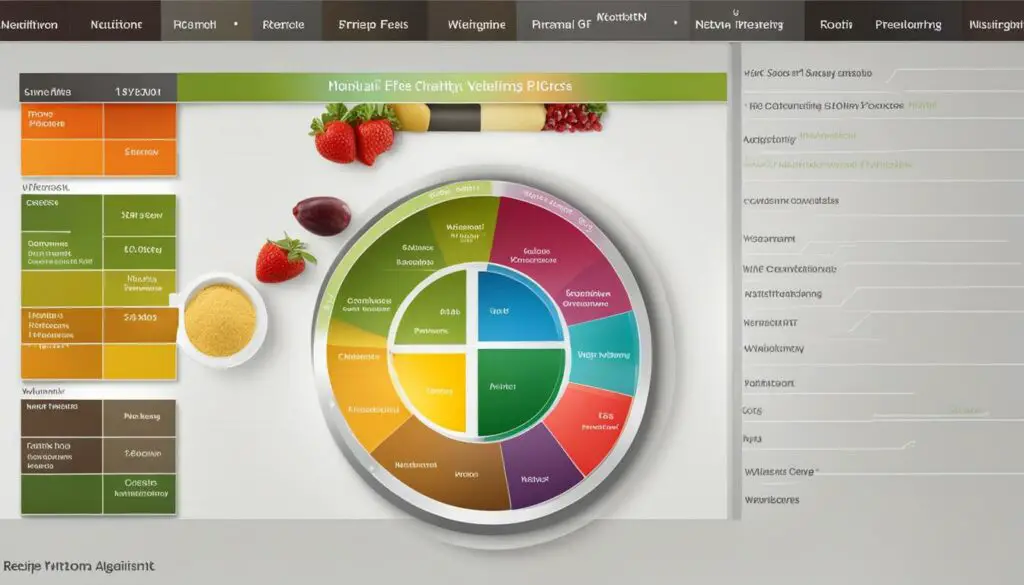
Understanding the nutritional content of recipes is crucial for individuals who prioritize their health and for professionals in the culinary industry. By conducting thorough nutrition analysis, recipe writers can provide valuable information that enables readers to make informed choices about their dietary intake. Evaluating and utilizing this data effectively enhances the overall culinary experience.
When it comes to nutrition analysis, there are various options available. It’s important for recipe writers to be aware of these resources and choose the most suitable one for their needs. From online nutrition calculators to food composition databases, these tools provide accurate information about the macronutrient and micronutrient composition of ingredients and recipes.
As recipe writers, it’s essential to evaluate the nutritional information obtained from these analyses. This involves understanding the significance of the data, including calorie counts, fat, carbohydrates, protein, vitamins, and minerals. By comprehending the nutritional breakdown, writers can make informed decisions about ingredient substitutions or modifications to suit specific dietary requirements.
Furthermore, presenting this information in a reader-friendly format enhances the usability of recipes. Recipe writers should effectively communicate the nutritional content, enabling readers to quickly identify key health aspects of the dish. This can be achieved through clear headings, properly organized tables, or concise bullet points presenting the nutritional information.
Overall, nutrition analysis plays a vital role in providing valuable information to readers, empowering them to make educated decisions about their diets. As recipe writers, understanding and effectively utilizing this information elevates the trustworthiness and reliability of your recipes among health-conscious individuals. By making the nutritional content accessible and easy to interpret, you cater to a wider audience, fostering a nutritious and enjoyable culinary experience.
Food Styling, Photography, and Video: Visual Appeal
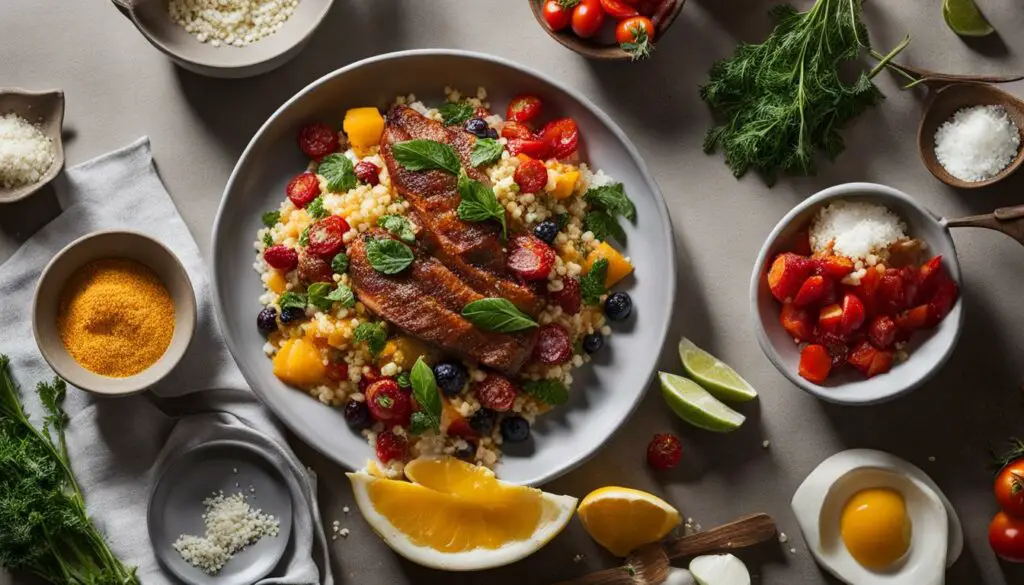
The visual appeal of a recipe is essential in capturing the attention and interest of readers. With the right food styling, photography, and video techniques, you can create captivating visuals that enhance the overall presentation of your recipes.
Food Styling Tips
Food styling is the art of arranging and presenting food in an appealing and appetizing way. Consider these professional tips to elevate your food styling skills:
- Choose fresh and high-quality ingredients that look vibrant and appetizing.
- Use props and accessories that complement the dish and create an appealing scene.
- Pay attention to colors, textures, and shapes to create visual interest.
- Focus on creating a sense of balance and composition in your food arrangements.
- Experiment with different plating techniques and presentation styles to find what works best for each recipe.
Photography and Video Techniques
Incorporating visually stunning photography and videos can greatly enhance the appeal of your recipes. Consider these professional tips to create visually captivating images and videos:
- Use natural lighting whenever possible for a soft and vibrant look.
- Experiment with different angles and perspectives to add depth and interest.
- Consider the rule of thirds and leading lines to create a visually pleasing composition.
- Use props, backgrounds, and textures that complement the style and theme of your recipes.
- Invest in quality photography and video equipment to achieve professional-looking results.
Remember to showcase the key elements of the dish, such as the texture, colors, and presentation, in your visuals. This will entice readers and inspire them to give your recipe a try.
Case Study: Food Styling and Photography
“The use of food styling and photography transformed our recipe blog. Our readers were drawn to the mouthwatering images and started sharing our recipes with their friends and family. The visual appeal greatly contributed to the success and popularity of our blog.”
– Joanna Smith, Food Blogger
By implementing these professional tips and techniques, you can create visually stunning recipes that leave a lasting impression on your audience. The combination of food styling, photography, and videos will enhance the visual appeal of your recipes, making them irresistible to readers.
The Rules for Recipe Writing: Tips and Strategies
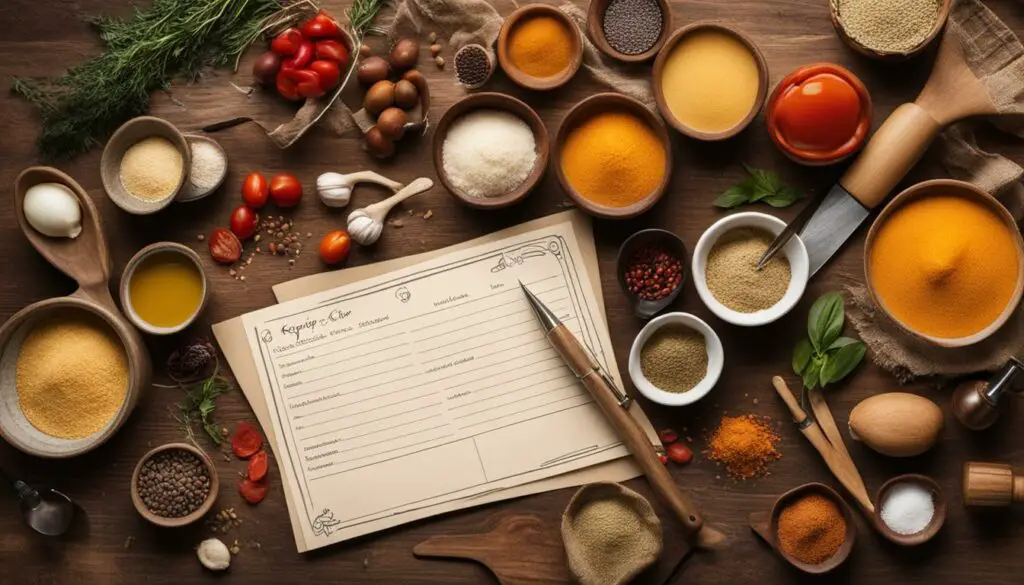
Writing a good recipe requires following specific rules and implementing effective strategies. By understanding these guidelines, you can create recipes that are easy to read, follow, and replicate. Here are some essential tips to enhance your recipe writing skills:
Know Your Audience
Consider who will be using your recipe and write with their cooking knowledge in mind. Tailor your language and instructions to suit beginners or more experienced home cooks.
Use Descriptive Recipe Titles
Choose recipe titles that clearly indicate what the dish is, highlighting its key ingredients or unique features. This helps readers quickly identify if the recipe aligns with their preferences and needs.
Add Recipe Descriptions
Include a brief introduction or description of the recipe. This can include details about the dish’s flavors, origins, or any interesting background information that will engage readers.
List Preparation and Cooking Times
Provide accurate estimates for the time required to prepare and cook the recipe. This helps readers plan their cooking activities and manage their time effectively.
Provide Serving Sizes
Specify the number of servings the recipe yields. This allows readers to adjust the quantities accordingly based on their needs and helps them plan for leftovers or larger gatherings.
Organize Ingredients and Steps
Clearly separate the ingredient list from the step-by-step instructions. Use formatting techniques like bullet points or numbered lists to make it easier for readers to follow along.
Be Specific
Use precise measurements for ingredients and clearly describe any required techniques. This prevents confusion and ensures accurate results when readers recreate your recipe.
Offer Additional Information
Provide extra details that are relevant and helpful to the reader. This can include nutritional analysis, storage suggestions, variations, or tips for ingredient substitutions.
By following these rules and leveraging effective strategies, you can write recipes that are clear, engaging, and enjoyable for your audience. The next section will delve into valuable recipe writing tips and advice from experienced dietitians and bloggers.
Recipe Writing Tips from Dietitians and Bloggers
In addition to the basic rules of recipe writing, experienced recipe writers, including dietitians and bloggers, have valuable tips and advice to enhance your recipe writing process. Take inspiration from their expertise and implement these tips for crafting clear, concise, and engaging recipes.
1. Keep a Recipe Journal
Journaling your recipe ideas and experiments can be incredibly helpful in the recipe writing process. By documenting your thoughts, ingredient combinations, and adjustments, you can keep track of your recipe development journey and refer back to your successful creations when needed. This practice helps foster creativity and ensures you don’t forget any important details while writing the final recipe.
2. Thoroughly Test Your Recipes
Before publishing a recipe, it’s essential to test it multiple times to ensure its accuracy and reproducibility. Experimenting with different cooking techniques, ingredient ratios, and flavors will help you fine-tune your recipe and provide your audience with reliable instructions for achieving the desired results. Remember to jot down your observations during the testing process to improve your recipe’s clarity and effectiveness.
3. Enlist the Help of Taste Testers
Involve taste testers in your recipe development process to gather valuable feedback on flavor, texture, and overall appeal. Seek opinions from friends, family, or members of your community who have diverse tastes and preferences. Their input can help you refine your recipe and make any necessary adjustments to ensure its wide appeal.
4. Embrace Simplicity and Clarity
When writing a recipe, strive for simplicity and clarity. Use concise language and avoid jargon or complicated techniques that may confuse readers. Break down the steps into clear instructions, ensuring that each action is easily understandable and achievable for home cooks of all skill levels. Remember that a well-written recipe should guide and inspire, making the cooking process enjoyable and accessible.
5. Invest in Quality Food Photography
Visuals are a powerful component of recipe writing. Invest in quality food photography to capture enticing images of your finished dish. High-resolution images that showcase the textures, colors, and presentation of your recipe can captivate readers and entice them to try your creation. Good photography can elevate your recipe writing and help you connect with your audience on a deeper level.
Conclusion
Crafting recipes is an art that requires attention to detail, clarity, and creativity. A well-written recipe not only provides clear instructions but also captures the essence of a culinary creation. This recipe writing guide has provided valuable insights into the process of crafting recipes that are easy to understand and replicate.
By following the guidelines and tips outlined in this guide, both professional recipe developers and home cooks can elevate their culinary creations. Clarity is crucial in recipe writing, ensuring that every step is communicated effectively. Creativity comes in play when presenting unique flavor combinations and innovative cooking techniques.
Remember, recipe writing is not just a technical task. It is an opportunity to express your passion for food and share your culinary expertise. Whether you are crafting recipes for a professional purpose or for your personal enjoyment, strive for clarity, precision, and originality in your writing. A well-written recipe not only serves as a guide but also inspires and encourages others to embrace their own culinary adventures.
In conclusion, this recipe writing guide has provided a comprehensive understanding of the art of crafting recipes. By combining the principles of clarity and creativity, you can create recipes that not only engage readers but also enable them to recreate your culinary masterpieces. So, pick up your pen, unleash your creativity, and start writing recipes that will delight and inspire others!
FAQ
What is recipe development?
Recipe development is the process of creating flavor-focused recipes that accommodate different dietary needs, such as plant-based diets, food allergies and sensitivities, celiac disease, FODMAP intolerance, and modifications for fat, sodium, and sugar content.
What is recipe writing?
Recipe writing is the process of translating cooking instructions into clear and concise words. It involves ensuring clarity, consistency, proper grammar, spelling, punctuation, and adhering to different recipe writing styles.
Why is recipe testing important?
Recipe testing is crucial to ensure that a recipe can be replicated with consistent results. Professional testers rigorously test the instructions to ensure accuracy and that the desired outcome can be achieved by home cooks.
Why is understanding the nutritional content of recipes important?
Understanding the nutritional content of recipes is important for health-conscious individuals and professionals. Recipe writers should be aware of options for nutrition analysis, how to evaluate and utilize them effectively, and making nutritional information accessible to readers.
How important is visual appeal in a recipe?
Visual appeal plays a significant role in attracting and engaging readers. Food styling, photography, and video skills are essential for creating captivating visuals.
What are some tips for writing a good recipe?
Important tips for writing a good recipe include knowing the audience, using descriptive recipe titles, adding recipe descriptions, listing preparation and cooking times, providing serving sizes, organizing ingredients and steps, being specific, and offering additional information such as nutritional analysis and storage suggestions.
Are there any valuable tips from experienced recipe writers?
Yes, there are valuable tips and advice from experienced recipe writers. Some suggestions include keeping a journal for recipe ideas, thoroughly testing recipes before publishing, enlisting taste testers, keeping instructions clear and simple, and investing in quality food photography.
What is the goal of recipe writing?
The goal of recipe writing is to create well-written recipes that are easy to understand and replicate. Whether you are a professional recipe developer or a home cook, mastering the skill of recipe writing will elevate your culinary creations.

